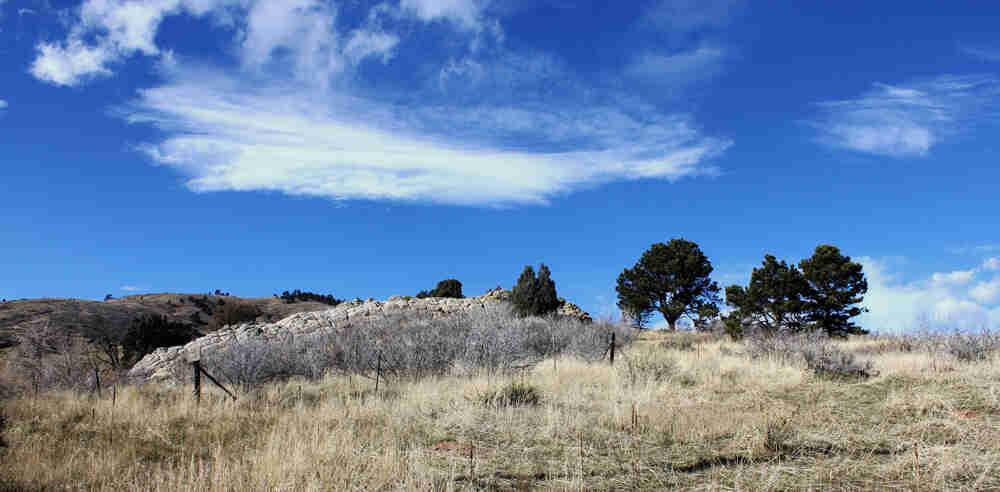Magic Mountain Archaeological Site
Full Article
Named for a nearby amusement park now known as Heritage Square, the Magic Mountain Archaeological Site south of Golden was excavated in 1959–60 by Cynthia and Henry Irwin. Because it was one of the first foothills sites to be professionally excavated, the Irwins’ report on Magic Mountain has provided the foundation for all later archaeological research in the region. In the 1990s new excavations discovered thousands of artifacts and bone fragments as well as several architectural features, which have helped provide more precise dates and cultural affiliations for the site.
Early Digging
There has probably been digging and collecting at the Magic Mountain site since the mid-1800s, when the mining town of Apex was established where the Heritage Square parking lot is today. Extensive looting of surface deposits at the site started in the 1920s and increased as it became more widely known. By the 1940s the top layer of soil had been looted so extensively that it reportedly looked like a cratered minefield.
In the early 1940s amateur archaeologists Jack Putnam and Robert Akerley alerted the Denver Museum of Natural History (now the Denver Museum of Nature and Science) to the potential significance of the site, and in 1941 two museum archaeologists, Elizabeth and Harold Huscher, performed test excavations and recovered a burial.
Peabody Museum Excavations
In 1957 Cynthia Irwin (later Irwin-Williams) and her brother, Henry, both then studying at Harvard University, started excavations at the LoDaisKa site south of Morrison. The Irwins’ work at LoDaisKa opened up new questions about the cultural history of the Front Range foothills, which had seen little previous professional archaeological research. The next year Putnam and Ackerley told the Irwins about the Magic Mountain site, which they soon visited. Despite decades of looting and amateur digging, they found enough cultural material to make them think a full excavation would help answer some of the questions about the foothills that had been raised by their work at LoDaisKa.
The Irwins excavated the Magic Mountain site in 1959–60. Their work, sponsored by the Peabody Museum of Harvard University, revealed significant cultural deposits at least thirteen feet deep, representing thousands of years of use. They found six soil zones containing at least four distinct cultural complexes, which they used to outline a chronology for the foothills region. The earliest cultural unit at the site was named the Magic Mountain complex and was believed to date to the latter part of the Early Archaic period (6650–3800 BCE). Slightly more recent was the Apex complex in the Middle Archaic period (3800–1250 CE). The two most recent cultural units dated to the Early Ceramic period (100–1050 CE). The site probably also saw more recent Middle Ceramic (1050–1450) occupations, but evidence of those has been lost to looters.
The excavation formed the basis for Cynthia Irwin’s 1963 dissertation, which was revised into a 1966 monograph by both Irwins. Published by the Denver Museum of Natural History, their monograph established a framework for the chronological sequence of the foothills and has become a foundational work for all subsequent archaeological research in the region.
Recent Research
In 1960 the Magic Mountain Amusement Park (now Heritage Square) was the only development near the Magic Mountain site, but by the 1970s Golden’s growth and Denver’s suburban sprawl had begun to encroach upon the unmarked site. In 1978 Bill Butler, a National Park Service archaeologist, drove by the site and saw that a new housing development was threatening it from the north. Butler and the state archaeologist were able to work with the developer to keep the site untouched, and in 1980 it was listed on the National Register of Historic Places. Since then the site has been hemmed in on all sides by new houses, roads, and bike paths. It is now on land owned mostly by the city of Golden, which maintains it as undeveloped open space.
In the 1990s the city of Golden and Centennial Archaeology received two State Historical Fund grants to investigate the site again and determine how much cultural material remained. The project emphasized public education and allowed for tours by school groups, lectures to amateur archaeology groups, and other public outreach efforts, including the use of amateur volunteers. Over the course of two field seasons, 1994 and 1996, volunteers led by Christian Zier and Stephen Kalasz collected more than 40,000 lithic artifacts, more than 20,000 bone fragments, and 83 ceramic sherds, all of which were deposited in the Denver Museum of Nature and Science. The density of artifacts suggested that Magic Mountain was the site of a series of long-term occupations during the Early Ceramic period in addition to several earlier Archaic-period occupations.
Volunteers also discovered the remains of two prehistoric structures, including a large dry-laid rock wall. The structures were located in a soil zone dating to the Early Ceramic period and had some similarities with other Early Ceramic structures along the Front Range as well as with some Apishapa structures south of Colorado Springs. The presence of a dense and diverse collection of artifacts along with some architectural elements indicated that the site was probably a residential base. It may have served as a well-protected fall and winter home for people who spent the rest of the year as mobile hunter-gatherers.
Future research at the site could yield more information about Archaic-period occupations and possible earlier Paleo-Indian deposits nearby.




